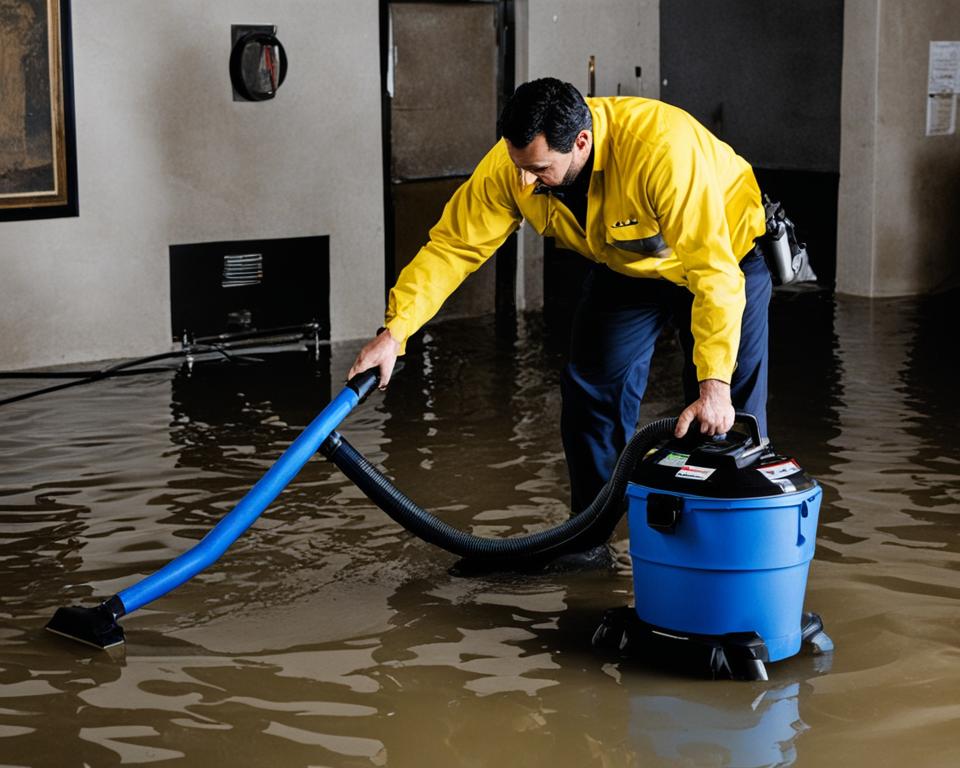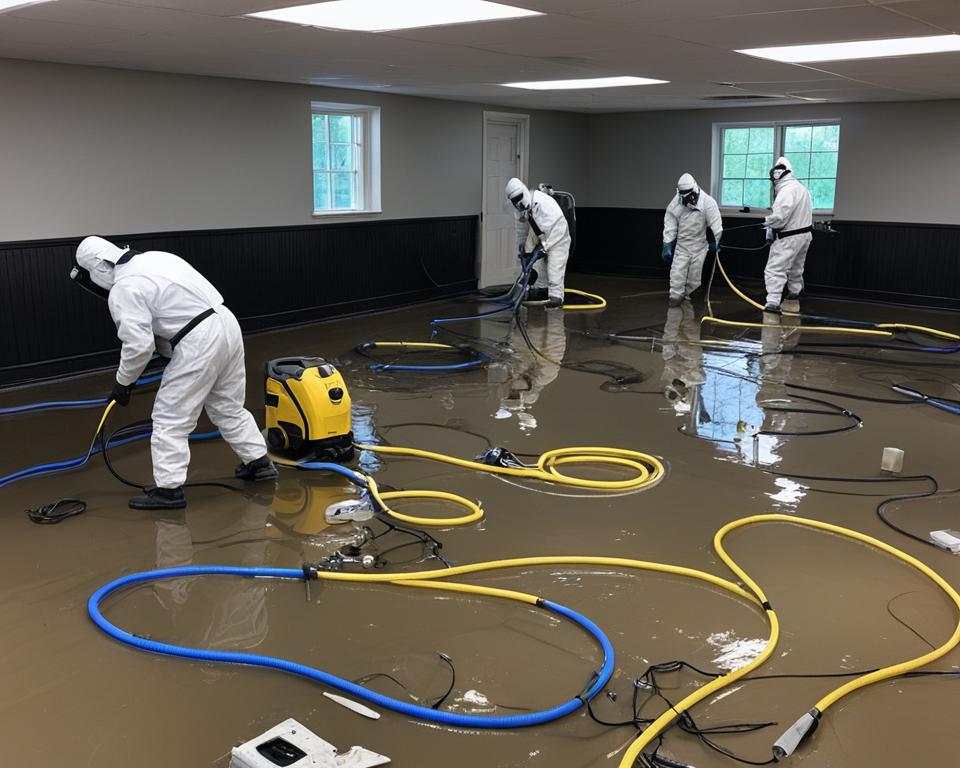Water damage restoration is a crucial process that involves returning a property to its original state after water intrusion. Whether it’s caused by a burst pipe, natural disaster, or any other water-related incident, the restoration process requires a systematic approach to ensure effective results. From inspecting the damage to repairing and sanitizing the affected areas, each step plays a vital role in restoring the property and preventing further issues.
Key Takeaways:
- Water damage restoration is essential in restoring a property to its pre-damaged condition.
- The process involves multiple steps, including inspection, extraction, dehumidification, sanitation, and reconstruction if required.
- Water damage can lead to structural damage and health risks, making prompt restoration crucial.
- Professional water damage restoration services are equipped with the necessary tools and expertise to ensure thorough restoration.
- Identifying the major causes and signs of water damage can help prevent further issues and facilitate timely restoration.
Importance of Water Damage Restoration
Water damage restoration is of utmost importance when dealing with water intrusion in a property. Ignoring water damage can lead to severe consequences, including structural damage, safety hazards, and long-term health risks. Hiring a professional water damage restoration company near you is essential to ensure a thorough and efficient restoration process.
Water damage can compromise the structural integrity of a building, causing collapsed walls, ceilings, and floors. These damages not only affect the aesthetics but also pose significant safety risks to the occupants. Additionally, untreated water damage creates an ideal environment for mold, bacteria, and pest infestations to thrive, further exacerbating health hazards.
A professional water damage restoration company has the expertise, experience, and specialized equipment necessary to address all aspects of water damage. They can assess the extent of the damage, identify hidden moisture sources, and develop an effective restoration plan to mitigate further risks.
By engaging a water damage restoration company near you, you ensure that the restoration process is carried out promptly and efficiently. Professionals in the field have access to advanced drying and dehumidification equipment, allowing them to remove moisture effectively and prevent long-term damage, such as mold growth. Moreover, they possess the knowledge to conduct thorough sanitization and cleaning, eliminating any potential health hazards associated with contaminants in the water.
In summary, water damage restoration is crucial for minimizing the impact of water intrusion, safeguarding the building structure, ensuring the well-being of occupants, and preventing long-term health risks. Hiring a professional water damage restoration company in your area is the best way to ensure a successful restoration process.
The Benefits of Professional Water Damage Restoration
When facing water damage, it’s essential to enlist the services of a professional water damage restoration company. Here are some of the key benefits they provide:
- Expertise: Professionals have the knowledge and experience to accurately assess the extent of the damage and develop a comprehensive restoration plan.
- Efficiency: With the right equipment and techniques, professionals can complete the restoration process efficiently, minimizing downtime and reducing further damages.
- Health Safety: Professionals understand the potential health risks associated with water damage and take necessary precautions to ensure safe handling and disposal of contaminated materials.
- Mold Prevention: Professionals use advanced drying techniques to prevent mold growth, protecting both the structure and the health of occupants.
- Insurance Assistance: Water damage restoration companies can help navigate the insurance claims process, ensuring that you receive the compensation you deserve.
Choosing the Right Water Damage Restoration Company
When selecting a water damage restoration company, it’s crucial to consider the following factors:
| Factors to Consider | Details |
|---|---|
| Licensing and Certification | Ensure the company holds the necessary licenses and certifications to perform water damage restoration services. |
| Experience and Reputation | Choose a company with extensive experience in handling water damage restoration projects and positive customer reviews. |
| Availability and Response Time | Find a company that offers 24/7 emergency services and can respond promptly to mitigate further damage. |
| Insurance Coverage | Verify that the company carries adequate liability insurance to protect both you and their workers throughout the restoration process. |
| Transparent Pricing | Request detailed pricing information and ensure there are no hidden costs or surprise fees. |
By conducting thorough research and considering these factors, you can choose a reliable and reputable water damage restoration company near you.
Causes and Signs of Water Damage
Water damage can have various causes, ranging from small household accidents to major disasters. It is important to be aware of the common causes and signs of water damage to address the issue promptly and prevent further damage. This section provides valuable insights into the causes and signs of water damage, along with essential tips for water damage restoration.
Causes of Water Damage
Water damage can occur due to various factors. Some common causes include:
| Cause | Description |
|---|---|
| Air conditioning unit condensation | Condensation from air conditioning units can drip and cause water damage to walls, ceilings, and floors. |
| Natural disasters | Heavy rain, flooding, hurricanes, and storms can result in water intrusion and extensive damage to properties. |
| Broken household appliances | Leaking pipes, malfunctioning washing machines, dishwashers, and refrigerators can cause water damage. |
| Clogged drains and gutters | Blocked drains and gutters can lead to water overflow, causing damage to the interior and exterior of a property. |
| Septic tank and sewer backups | When septic tanks and sewer lines back up, water can enter the property, resulting in significant damage and health hazards. |
| Burst or leaking pipes | Pipes can burst or develop leaks due to freezing temperatures, aging, corrosion, or high water pressure, leading to water damage. |
| Old or faulty water heaters | Old or malfunctioning water heaters can leak or burst, causing water damage and potential hazards. |
| Damaged sprinkler systems | Broken or misdirected sprinkler systems can result in water accumulation near the foundation, leading to structural damage. |
| Water overflow from toilets | Overflowing toilets can release a significant amount of water, causing damage to the bathroom and adjacent areas. |
| Inoperative sump pumps | Sump pump failure during heavy rainfall can result in water accumulation in basements and lower levels of a property. |
Signs of Water Damage
Recognizing the signs of water damage is crucial for timely intervention. Look out for the following indicators:
- Swollen or warped materials
- Cracks on ceilings or walls
- Peeling or bubbling paint
- Musty or damp odors
- Sagging or soft spots
- Structural damage
- Puddles of water
- Mold or mildew growth
- Water stains
These signs often indicate water infiltration or leakage and require immediate attention to prevent further damage and potential health risks.
Water Damage Restoration Process
When faced with water damage, it is essential to embark on the restoration process as swiftly as possible. Effective and efficient water damage restoration includes several crucial steps to ensure the property’s complete recovery. Let’s take a closer look at each step:
- Water Damage Inspection: A thorough assessment of the extent of the damage, the source of the water, and its contamination level is conducted by a water damage restoration specialist. This step helps determine the appropriate course of action for effective restoration.
- Removal of Standing Water: The immediate extraction of standing water is vital to prevent further damage and mitigate potential health hazards. Specialized equipment such as pumps and vacuums are used to remove the water safely and efficiently.
- Drying and Dehumidifying Affected Areas: Once the standing water is removed, the affected areas must be thoroughly dried to prevent the growth of mold and further damage. Fans, dehumidifiers, and other drying equipment are strategically placed to expedite the drying process.
- Cleaning and Sanitizing All Surfaces: The next step involves cleaning and sanitizing all surfaces to eliminate contaminants, bacteria, and odors. Specialized cleaning solutions and equipment are used to ensure the removal of any residue left by the water damage.
- Repair/Reconstruction: In cases where the water damage has caused significant structural or material damage, repair or reconstruction may be necessary. This step involves restoring the affected areas to their pre-damage condition, including replacing damaged materials and repairing structural components.
By following these water damage restoration steps, property owners can effectively minimize damage, restore the property’s integrity, and create a safe and healthy living environment once again.

Water Damage Restoration Checklist
To ensure a thorough and efficient water damage restoration process, it is crucial to have a comprehensive checklist in place. This checklist will serve as a guide, outlining the key tasks that need to be completed to effectively restore a property after water damage. Here are the essential steps to include in your water damage restoration checklist:
- Conduct a water damage inspection: Begin by thoroughly inspecting the affected areas to assess the extent of the damage and identify any potential hazards. This step will help determine the scope of the restoration process.
- Remove standing water through extraction: Utilize professional-grade equipment such as pumps and vacuums to remove any standing water. The prompt removal of water is crucial in preventing further damage and reducing the risk of mold growth.
- Dry and dehumidify affected areas: Use industrial fans, dehumidifiers, and specialized drying techniques to eliminate excess moisture from the affected surfaces and the air. This step aids in preventing mold growth and further structural damage.
- Clean and sanitize all surfaces: Thoroughly clean and sanitize all affected surfaces to eliminate bacteria, mold, and other contaminants. Use appropriate disinfectants and cleaning agents to ensure a safe and healthy environment.
- Repair/reconstruct damaged areas if necessary: Assess the extent of the damage and determine if any repairs or reconstruction are required. Replace or repair damaged materials, such as flooring, drywall, insulation, or structural elements, to restore the property to its pre-damaged condition.
It’s important to note that the cost of water damage restoration can vary depending on various factors, including the extent of the damage, the required repairs, and the location. It is advisable to consult with a professional water damage restoration company for a detailed cost estimate.

By following a comprehensive water damage restoration checklist, you can ensure that the process is carried out efficiently and effectively, minimizing further damage and safeguarding the health and safety of the property’s occupants.
Categories and Classes of Water Damage
Water damage can be classified into different categories and classes based on the level of contamination and the extent of damage. Understanding these categories and classes is crucial in determining the appropriate water damage restoration process.
Categories of Water Damage
Water damage is categorized into three main categories:
- Category 1: Clean Water
- Category 2: Gray Water
- Category 3: Black Water
Category 1: Clean water refers to water from clean sources such as a broken pipe or faucet leak. It doesn’t pose a significant health risk.
Category 2: Gray water is slightly contaminated and may come from sources such as washing machines, dishwashers, or toilet overflow containing urine but no feces.
Category 3: Black water is highly contaminated and poses serious health risks. It may contain sewage, bacteria, and other hazardous substances. Examples include water from sewage backups, floods, or standing water that hasn’t been properly treated.
Classes of Water Damage
Water damage is also classified into different classes based on the amount of water present and the materials affected:
| Class | Description |
|---|---|
| Class 1 | Minimal Water Leakage |
| Class 2 | Significant Water Leakage and Fast Evaporation |
| Class 3 | Fastest Evaporation Rate; Water Affected Walls, Ceilings, and Floors |
| Class 4 | Significant Water Trapped, Affecting Confined Spaces and Porous Materials |
Class 1 water damage involves minimal water leakage on low-porosity materials such as concrete or hardwood floors. It has the least amount of moisture to evaporate.
Class 2 water damage includes significant water leakage and fast evaporation, often affecting carpeting and cushions.
Class 3 water damage has the fastest evaporation rate and affects walls, ceilings, and floors. The water may come from overhead sources and can cause structural damage.
Class 4 water damage involves significant water trapped in confined spaces, such as walls and subfloors, and affects porous materials like insulation and building materials.
By understanding the categories and classes of water damage, homeowners and restoration professionals can better assess the severity of the damage and implement appropriate restoration measures.
Tips for Effective Water Damage Repair and Restoration
When dealing with water damage, it is crucial to follow certain tips to ensure effective repair and restoration. The first priority should always be safety. Shut off the electricity and water supply to prevent any further damage or potential hazards. Next, assess the extent of the damage and determine its category and class. This will help guide the restoration process.
Wearing appropriate protective gear is essential to safeguard against any potential health risks. Hiring professionals experienced in water damage restoration is highly recommended. They have the expertise and equipment to thoroughly inspect the affected areas and carry out proper restoration procedures.
Documenting the damage is important for insurance purposes. Take photographs and make a detailed inventory of the affected items. This will help streamline the claims process. Additionally, maintaining optimal humidity levels in the affected areas is crucial to prevent mold growth. This can be achieved through proper ventilation, dehumidification, and regular monitoring.
Finally, whenever possible, consider restoration rather than complete replacement of damaged materials. Restoration techniques can often salvage and repair items that may seem beyond repair. This approach not only saves time and money but also helps preserve sentimental or valuable possessions.
FAQ
What is water damage restoration?
Water damage restoration is the process of returning a property to its original state after water intrusion. It involves steps such as inspection, extraction, dehumidification, sanitation, and reconstruction if necessary.
Why is water damage restoration important?
Water damage restoration is important because it helps prevent further structural damage, ensures the safety of building occupants, and minimizes long-term health risks.
What are the major causes and signs of water damage?
The major causes of water damage include air conditioning unit condensation, natural disasters, broken household appliances, clogged drains and gutters, burst or leaking pipes, and more. Signs of water damage include swollen/warped materials, cracks on ceilings or walls, musty/damp odors, and water stains.
What are the steps involved in the water damage restoration process?
The water damage restoration process typically involves five steps: inspection, removal of standing water, drying and dehumidifying affected areas, cleaning and sanitizing surfaces, and repair/reconstruction if necessary.
What should be included in a water damage restoration checklist?
A water damage restoration checklist should include tasks such as conducting an inspection, removing standing water, drying and dehumidifying affected areas, cleaning and sanitizing surfaces, and repairing/reconstructing damaged areas if necessary.
How is water damage categorized?
Water damage can be categorized into three categories based on the level of contamination: category 1 (clean water), category 2 (gray water), and category 3 (black water).
What are the classes of water damage?
Water damage can be classified into four classes based on the amount of water present and the materials affected. Class 1 involves minimal water leakage on low-porosity materials, while class 4 involves significant water trapped in confined spaces and affecting porous materials.
What are some tips for effective water damage repair and restoration?
Some tips for effective water damage repair and restoration include prioritizing safety, assessing the extent of the damage, wearing protective gear, hiring professionals, documenting the damage for insurance purposes, maintaining optimal humidity levels, and considering restoration rather than complete replacement of damaged materials when possible.

Leave a Reply